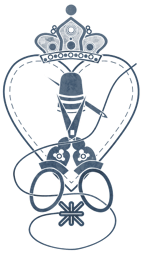My Personal Favorites
Here is a small collection of my favorite work:
I am changing my list from five.
I will tell the story of each as I post it. For several, I have told the stories many times, others this is the first time.
This is my Acorn Sampler
Acorn Sampler
Acorn Sampler, Part 1 History
A traditional band sampler of traditional bands of acorns. If you look carefully, you will see that there are acorns in each majorband except the alphabet band.
Starting from the top, the bands are of Double Running Stitch, a traditional drawn thread technique, more Double Running Stitch, the center of a 'bouquet' of acrons, more Double Running Stitch, Reticella, an alphabet and Cross Stitch.
A non-stitching friend once asked me if I had any idea why acorns appear on so much historical needlework. Obviously for the symbolism, but I think there is another reason: they lend themselves to needlework so well, and in so many forms.
In my days of travel teaching, I made this sampler for an EGA Seminar and then taught it at Callaway Gardens and at various regional seminars and for various guild chapters around the country. In those days I was traveling a lot.

Acorn Sampler
Acorn Sampler, Part 2 Notes on the Various Techniques
My history with Double Running Stitch began with this sampler. Betty Chen Louis taught me how to do it, and we started with the large band of acorns at the top of the sampler. I had charted it off a traditional sampler during my English years and she showed me how to make the pattern reversible.
I had been doing cutwork for quite a while by the time I did this sampler and was becoming a bit more innovative with it, hence the appearance of the acorns in the drawn thread pattern at the top and the Reticella toward the bottom.
I have used this alphabet a number of times as I find it so interesting. At one EGA seminar I bought a wonderful second edition of Marcus Huish's book on samplers and according to the book, this alphabet is the oldest he knew of on samplers. If you have not seen his book and you are interested in samplers, the book has often been reprinted.
At the bottom of the sampler I did some Cross Stitch acorns. They are one of the few times I have done traditional Cross Stitch over 2 meshes. I use a lot of Cross Stitch here and there but almost always over 1 mesh.
Below are some closeups of the various bands
Acorn Sampler
A Long Band Sampler from My Travel-Teaching Days
Scroll down for notes and some closeups of this traditional band sampler




Acorn Sampler
Acorn Sampler, Part 3 More on My History with Double Running Stitch
As I said in Part 2, the band of Double Running Stitch at the top of the sampler (and on the immediate left) was the first one I charted and stitched. In those days I adhered carefully to making the motifs reversible, over 2 under 2, etc. (the band on the original sampler was over 3, under 3).
It wasn't too many years later that I began taking great liberties with Double Running Stitch. It happened when I began stitching Wrought Iron in Blackwork. I mean, how perfect is a stitch to make all those beautiful gates and fences that were part of my daily life in London.
The longer I used Double Running Stitch, the greater liberties I took, and it wasn't long before I was making patterns going sometimes over 2 meshes, sometimes over 3 and 4, off the true diagonal and with no hope of being reversible.
I remember at the height of my liberties I was teaching a sampler in Seattle and explaining not to worry about reversible Double Running Stitch because it wasn't possible. One of my students was so upset at this; she stood up and declared I was ruining a great art form and more than a few needlework teachers was turning over in their graves because of the way I was teaching this.
I answered her this way: but don't you think the wrought iron really looks like wrought iron, and isn't that the first responsibility of a stitch?
I can see both sides, particularly as I look at the band of acorns at the top of this sampler: so wonderfully precisely over 2 meshes and so easy to make reversible.
Acorn Sampler
Acorn Sampler, Part 4 Using Historical Patterns
I do like to use historical patterns but I prefer not to remain too true to them. I like to fiddle with them, so that they are a reflection on the past but they also are a part of my here and now.
There are two prominent people whose writings reflect this and I have often quoted them in my teaching days. These two are Joan Edwards and Carol Humphrey.
The gist of their arguments are the same: that the art of the sampler lives on only if we make it a reflection of our own time.
I love to borrow from old samplers, but I like to dream up what to do with a foundation of the past but a bit of innovation that belongs in the present.
This sampler is perhaps the most traditional I ever stitched.
